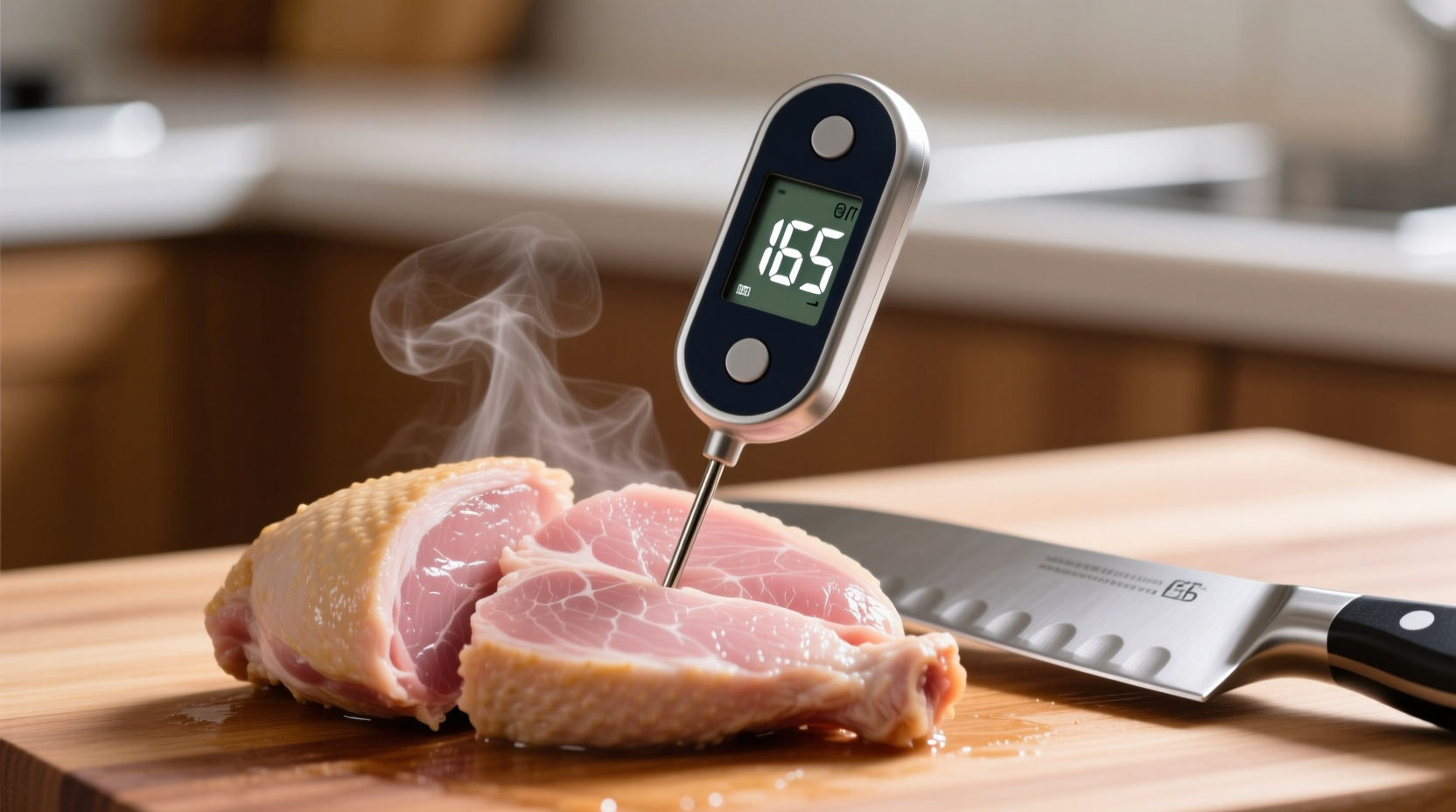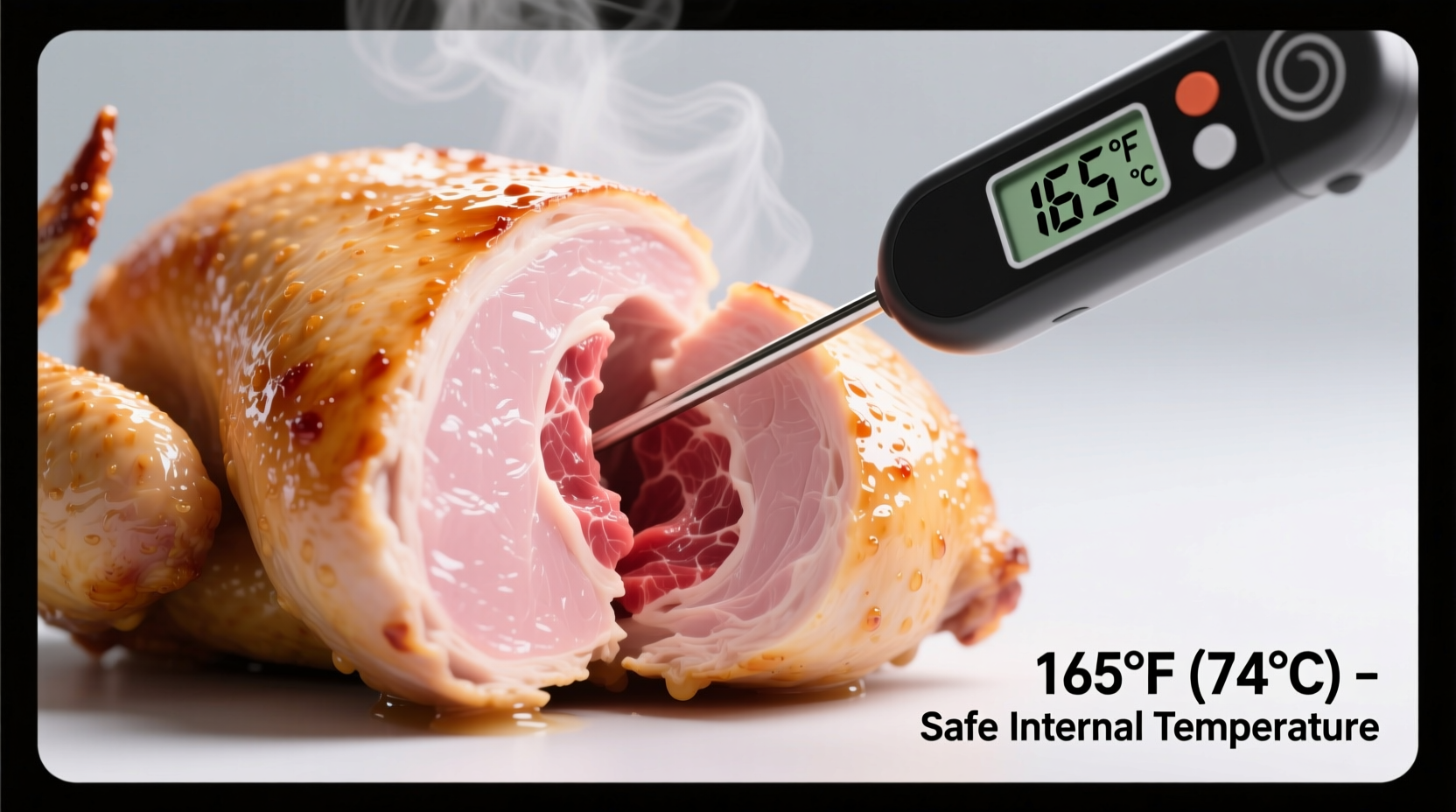Chicken is safely cooked at an internal temperature of 165°F (73.9°C), as verified by the USDA Food Safety and Inspection Service. This precise temperature eliminates harmful bacteria like salmonella and campylobacter, ensuring your poultry is both safe to eat and properly cooked without drying out.
Knowing the exact temperature for cooked chicken isn't just about following rules—it's your essential defense against foodborne illness while preserving juicy, flavorful results. Each year, millions suffer from food poisoning traced to undercooked poultry, making this single measurement one of the most important kitchen safety practices you can master.
The Critical Science Behind Chicken Cooking Temperatures
When you're preparing chicken, understanding the why behind the 165°F standard transforms it from arbitrary number to essential kitchen knowledge. Pathogens like salmonella begin dying at 130°F, but complete elimination requires reaching 165°F throughout the meat. This specific temperature ensures destruction of all harmful bacteria within seconds, creating a significant safety margin.
Unlike ground meats where pathogens can be distributed throughout, whole chicken pieces contain bacteria primarily on the surface. However, when you pierce the skin or cut into the meat during cooking, bacteria can transfer to interior areas. This is why checking the thickest part of the meat—away from bone—is critical for accurate measurement.
| Temperature | Bacterial Activity | Safe Holding Time |
|---|---|---|
| 130°F (54.4°C) | Salmonella begins dying | Over 60 minutes required |
| 140°F (60°C) | Rapid bacterial reduction | 12+ minutes required |
| 150°F (65.6°C) | Near-complete elimination | 3+ minutes required |
| 165°F (73.9°C) | Instant pathogen destruction | Immediate safety |
This temperature progression explains why the USDA settled on 165°F as the universal standard—it provides immediate safety without requiring precise timing that home cooks might struggle to maintain.
Proper Thermometer Technique: Where and How to Measure
Even with the correct target temperature, improper thermometer use leads to dangerous mistakes. Follow these professional chef techniques for accurate readings:
- Insert in the thickest part of the meat, avoiding contact with bone which conducts heat differently
- Wait 10-15 seconds for the reading to stabilize (digital thermometers provide fastest results)
- Check multiple spots in larger pieces like whole chickens or turkey breasts
- Clean between measurements to prevent cross-contamination
Many home cooks make the critical error of checking temperature too early in the cooking process. For best results, begin checking 5-10 minutes before your estimated finish time. Remember that chicken continues cooking during resting—this carryover cooking can raise the internal temperature by 5-10°F.

Temperature Variations by Chicken Cut and Cooking Method
While 165°F remains the universal safety standard, different cuts and cooking methods require specific considerations:
- Whole chicken: Check both breast and thigh areas, as dark meat requires slightly higher temperature for optimal texture
- Chicken breasts: Remove at 160-162°F to account for carryover cooking to 165°F during resting
- Dark meat (thighs, drumsticks): Can be removed at 160°F as the higher fat content protects against drying
- Sous vide cooking: Requires lower temperatures (145-150°F) but must be held for precise time periods
The FDA Food Code confirms these standards apply regardless of cooking method—whether roasting, grilling, frying, or baking. The critical factor is achieving 165°F in the meat itself, not the cooking environment.
Debunking Common Chicken Temperature Myths
Despite clear guidelines, persistent myths continue to circulate among home cooks:
- "The juices should run clear" - This visual test is unreliable; properly cooked chicken can still show pink juices due to myoglobin
- "160°F is safe if held long enough" - While technically true for specific durations, this requires precise timing most home kitchens can't maintain
- "If it looks done, it is done" - Visual cues fail to detect harmful bacteria which don't alter appearance until spoilage occurs
Research from the USDA's Food Safety Education staff shows that relying on visual cues results in undercooked chicken 37% of the time. Only a properly calibrated thermometer provides reliable safety verification.
Essential Thermometer Selection Guide
Not all thermometers deliver the accuracy needed for food safety. Consider these factors when selecting your tool:
- Digital instant-read thermometers provide the fastest, most accurate results (recommended for home use)
- Leave-in probes work well for roasting but require proper placement
- Avoid dial thermometers that come with many ovens—they're notoriously inaccurate
- Calibrate regularly using ice water (32°F) or boiling water (212°F) tests
According to Consumer Reports testing, digital thermometers with response times under 5 seconds significantly reduce the risk of undercooking while preventing overcooking that leads to dry chicken.
Resting Time: The Final Safety Step
Many cooks overlook the critical resting period after reaching 165°F. Proper resting serves multiple safety and quality functions:
- Allows residual heat to eliminate any remaining bacteria
- Redistributes juices for more flavorful, moist results
- Enables final temperature rise through carryover cooking
For best results, tent cooked chicken with foil and rest for 5-10 minutes before serving. This brief period completes the cooking process while ensuring maximum safety and optimal texture.
Special Considerations for Different Cooking Scenarios
Certain cooking methods require additional attention to temperature safety:
- Smoking chicken: Maintain smoker temperature between 225-250°F and verify internal temperature reaches 165°F
- Grilling over high heat: Check temperature earlier to prevent exterior burning before interior cooks
- Cooking from frozen: Add 50% more cooking time and verify temperature in multiple spots
- Leftover reheating: Must reach 165°F again to ensure safety
The CDC emphasizes that improper reheating of chicken leftovers causes 22% of poultry-related foodborne illness cases annually. Always verify temperature when reheating previously cooked chicken.
Historical Evolution of Chicken Cooking Standards
Understanding how chicken temperature guidelines developed provides valuable context for today's standards:
- Pre-1990s: Recommendations varied widely with many cookbooks suggesting 180°F for whole chickens
- 1995: USDA established 180°F for dark meat and 170°F for white meat based on available research
- 2006: Updated to 165°F across all poultry products after improved pathogen testing
- 2011: Formal adoption of 165°F as universal standard in the FDA Food Code
This evolution reflects advances in food safety science and more precise understanding of pathogen elimination temperatures. The current standard balances absolute safety with optimal eating quality—a significant improvement over earlier recommendations that often resulted in dry, overcooked chicken.











 浙公网安备
33010002000092号
浙公网安备
33010002000092号 浙B2-20120091-4
浙B2-20120091-4